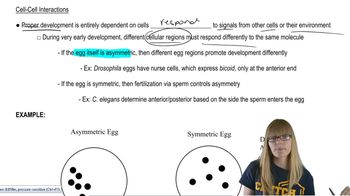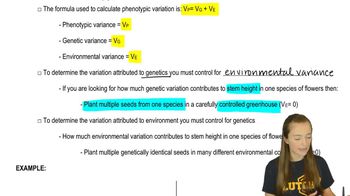Table of contents
- 1. Introduction to Genetics51m
- 2. Mendel's Laws of Inheritance3h 37m
- 3. Extensions to Mendelian Inheritance2h 41m
- 4. Genetic Mapping and Linkage2h 28m
- 5. Genetics of Bacteria and Viruses1h 21m
- 6. Chromosomal Variation1h 48m
- 7. DNA and Chromosome Structure56m
- 8. DNA Replication1h 10m
- 9. Mitosis and Meiosis1h 34m
- 10. Transcription1h 0m
- 11. Translation58m
- 12. Gene Regulation in Prokaryotes1h 19m
- 13. Gene Regulation in Eukaryotes44m
- 14. Genetic Control of Development44m
- 15. Genomes and Genomics1h 50m
- 16. Transposable Elements47m
- 17. Mutation, Repair, and Recombination1h 6m
- 18. Molecular Genetic Tools19m
- 19. Cancer Genetics29m
- 20. Quantitative Genetics1h 26m
- 21. Population Genetics50m
- 22. Evolutionary Genetics29m
11. Translation
Proteins
Problem 20
Textbook Question
Contrast the contributions of Pauling and Ingram to our understanding of the genetic basis for sickle-cell anemia.
 Verified step by step guidance
Verified step by step guidance1
Understand the context: Sickle-cell anemia is a genetic disorder caused by a mutation in the hemoglobin gene, leading to abnormal hemoglobin structure and function.
Explore Linus Pauling's contribution: Pauling was the first to demonstrate that sickle-cell anemia is a "molecular disease" by showing that the hemoglobin in sickle-cell patients had a different structure compared to normal hemoglobin. He used electrophoresis to separate the hemoglobin molecules based on their charge.
Examine Vernon Ingram's contribution: Ingram furthered the understanding by identifying the specific genetic mutation responsible for sickle-cell anemia. He used peptide mapping and sequencing to show that a single amino acid substitution (glutamic acid to valine) in the beta chain of hemoglobin was the cause of the disease.
Compare their contributions: Pauling's work laid the foundation by establishing the concept of a molecular basis for genetic diseases, while Ingram pinpointed the exact molecular change, providing a more detailed understanding of the genetic mutation involved.
Reflect on the impact: Together, their work highlighted the importance of molecular biology in understanding genetic disorders and paved the way for future research into genetic mutations and their effects on protein function.
Recommended similar problem, with video answer:
 Verified Solution
Verified SolutionThis video solution was recommended by our tutors as helpful for the problem above
Video duration:
1mPlay a video:
Was this helpful?
Key Concepts
Here are the essential concepts you must grasp in order to answer the question correctly.
Sickle-Cell Anemia
Sickle-cell anemia is a genetic blood disorder caused by a mutation in the hemoglobin gene, leading to the production of abnormal hemoglobin known as hemoglobin S. This mutation results in the distortion of red blood cells into a sickle shape, which can cause blockages in blood vessels, pain, and various complications. Understanding this condition is crucial for appreciating the genetic contributions made by researchers like Pauling and Ingram.
Recommended video:
Guided course

Cell-cell interactions
Linus Pauling's Contribution
Linus Pauling was a pioneering chemist who, in the 1940s, used electrophoresis to demonstrate that sickle-cell anemia was associated with a specific molecular change in hemoglobin. He proposed that the disease was caused by a single amino acid substitution in the hemoglobin protein, marking one of the first instances of linking a genetic mutation to a specific disease phenotype. This work laid the groundwork for molecular genetics and the understanding of genetic diseases.
Recommended video:
Guided course

Analyzing Trait Variance
Harold Ingram's Contribution
Harold Ingram expanded on Pauling's findings by conducting further studies that confirmed the relationship between the sickle-cell trait and the specific mutation in the beta-globin gene. Ingram's research provided a clearer understanding of the genetic basis of sickle-cell anemia, demonstrating how the mutation leads to the production of abnormal hemoglobin. His work was instrumental in establishing the field of molecular genetics and the concept of genetic disease inheritance.
Recommended video:
Guided course

Analyzing Trait Variance
Related Videos
Related Practice




